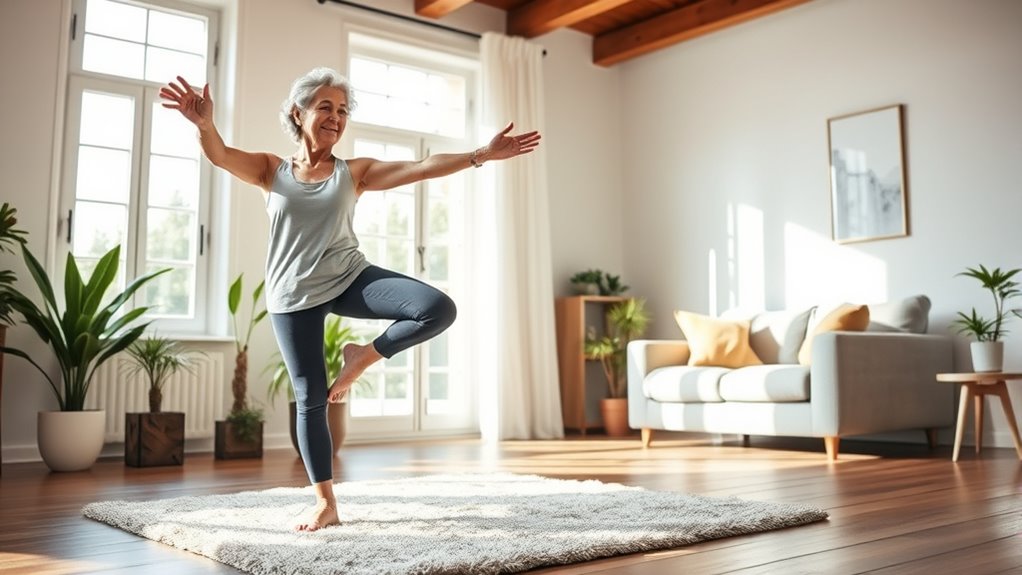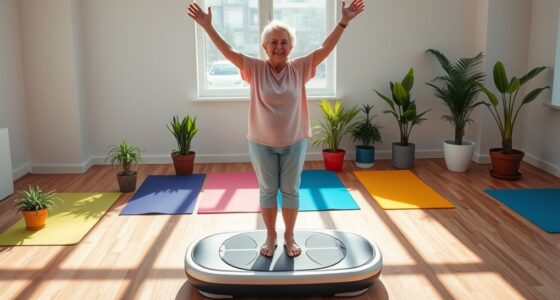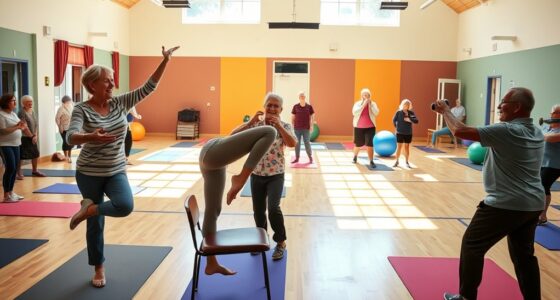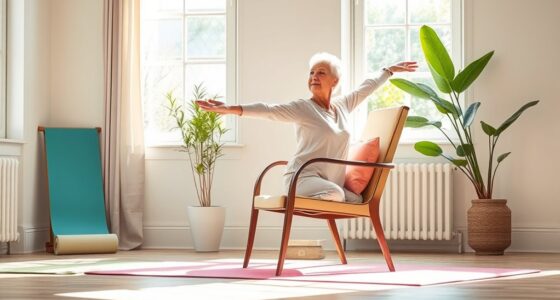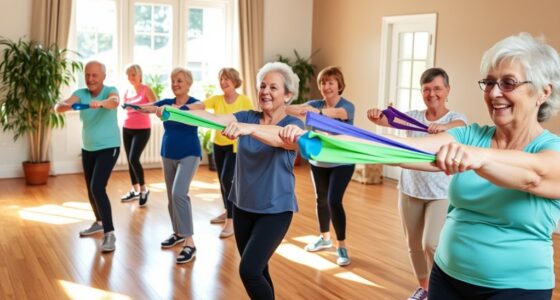To prevent falls, focus on simple balance exercises like standing with your feet shoulder-width apart, heel-to-toe walking, and lifting one foot for a few seconds. Incorporate strength training for leg muscles, and use supports like a chair for safety. Make sure to start slowly and progress gradually. Maintaining a routine helps improve stability over time. Keep going to discover more effective tips to stay steady and safe.
Key Takeaways
- Regular balance and strength exercises improve stability, coordination, and reaction time, reducing fall risk in older adults.
- Practicing activities like standing on one foot or heel-to-toe walking enhances proprioception and core stability.
- Using supports and safe environments ensures proper technique and prevents injuries during exercises.
- Incorporating strength training, such as sit-to-stands and heel raises, builds leg muscle support for better balance.
- Consistent routine and professional monitoring help sustain improvements and adapt exercises for long-term fall prevention.
Why Balance Exercises Are Essential for Older Adults
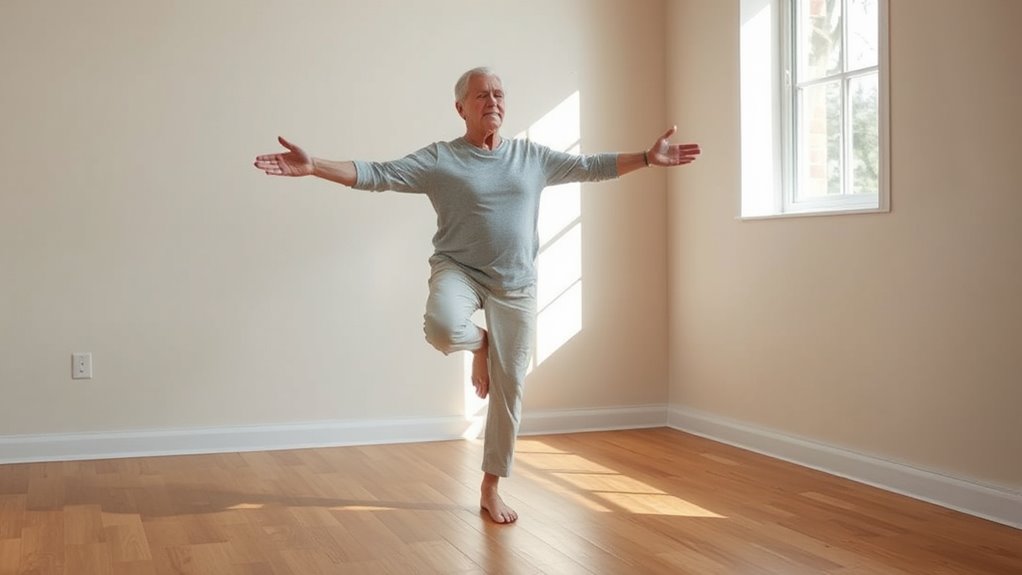
Balance exercises are crucial for older adults because they directly enhance core stability and proprioception, which are essential for maintaining proper posture and preventing falls. Improved balance reduces fall risk by boosting coordination and reaction times, helping you respond quickly to uneven surfaces or sudden movements. Regular exercise strengthens the leg muscles involved in stabilizing your body, increasing overall muscle strength and stability. This not only supports your daily activities but also makes you less prone to falls. Better proprioception helps you sense your body’s position, enabling safer movement. Incorporating balance-focused activities into your routine can markedly decrease fall incidents, empowering you to stay independent and active longer. These exercises are key for promoting safety and confidence in everyday life.
Key Safety Tips for Performing Balance Activities
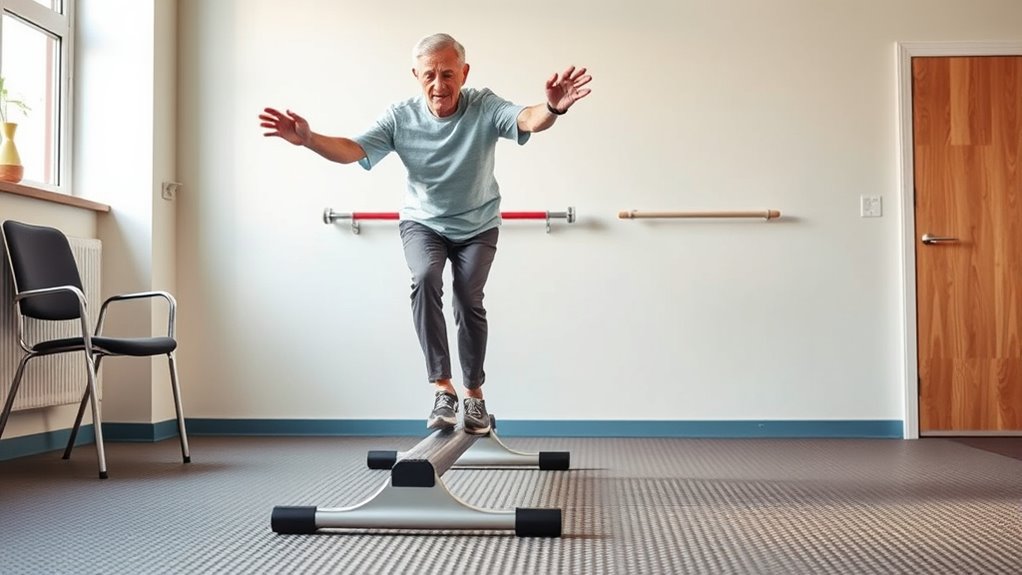
Are you aware of the key safety tips that can help you perform balance exercises confidently and safely? Always start near a sturdy support, like a chair or countertop, to prevent falls and enhance fall prevention. Hold onto the support with both hands initially, then gradually reduce your grip as your confidence and balance improve. Incorporate proper footwear to improve stability and reduce the risk of slipping during exercises. Keep good posture by tightening your tummy and engaging your core during exercises like heel-to-toe walking to boost stability. Move slowly and deliberately to reduce the risk of losing your balance. Make sure your exercise area is free of trip hazards, such as loose rugs or clutter, to create a safe environment. Maintaining a healthy home environment can also support your overall well-being and safety during balance activities. Being aware of fall prevention strategies is crucial for maintaining independence and safety. Ensuring your environment is free of trip hazards can significantly decrease the risk of falls and injuries. For example, understanding the horsepower of electric dirt bikes can help you choose safer, lower-powered models for your riding activities. Following these safety tips ensures you can strengthen your balance while reducing risk and maintaining confidence.
Simple Standing Balance Practices to Try at Home

You can easily improve your stability at home by practicing simple standing balance exercises. Start by standing with your feet shoulder-width apart and hold for 10-30 seconds to boost your overall standing balance.
Next, try standing with your feet together for up to 30 seconds to strengthen stability.
To enhance single-leg support, lift one foot and balance on the other for 5-10 seconds.
Incorporate heel-to-toe walking along a straight line to improve coordination and balance skills.
Always use a support surface, like a countertop or chair, for safety and confidence during exercises.
Keeping your posture upright and maintaining support nearby helps prevent falls and enhances your stability.
Regular practice of these balance exercises can considerably contribute to fall prevention at home. Security measures such as sturdy handrails and proper lighting also play a crucial role in creating a safer environment.
Effective Walking-Based Exercises to Improve Stability
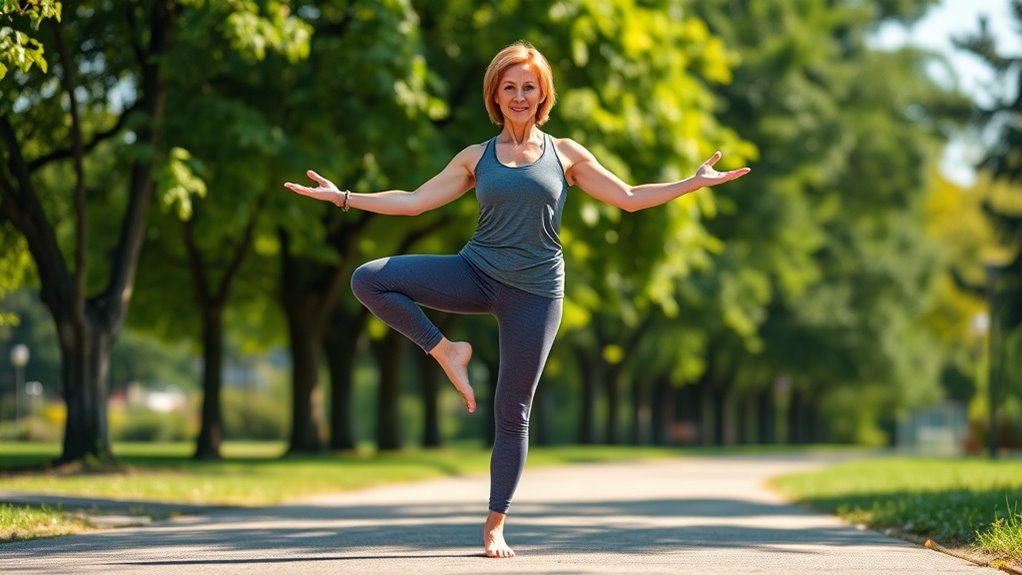
Building on simple standing exercises, incorporating walking-based activities can considerably enhance your stability and coordination. Using support, such as holding onto a counter or cane, helps maintain stability during these movements. Marking a straight line with tape allows you to practice heel-to-toe walking safely, strengthening gait and coordination. To challenge yourself further, try: 1. Walking on varied surfaces like grass or gravel 2. Practicing heel-to-toe walks along a taped line 3. Moving in different directions, including sideways and backward 4. Using support when needed to prevent falls. These exercises boost fall prevention by improving balance, stability, and overall gait control. Regular practice makes a real difference. Additionally, engaging in Bluetooth techniques that optimize device connectivity can serve as a metaphor for fine-tuning your body’s coordination and responsiveness, further supporting fall prevention efforts. Incorporating balance-focused activities like these enhances neuromuscular control, making everyday movements safer. Developing muscle strength through these exercises can also contribute to better postural stability and reduce fall risk. Improving proprioception through targeted walking exercises further enhances your awareness of body position, helping to prevent falls.
Incorporating Strength Training Into Your Routine
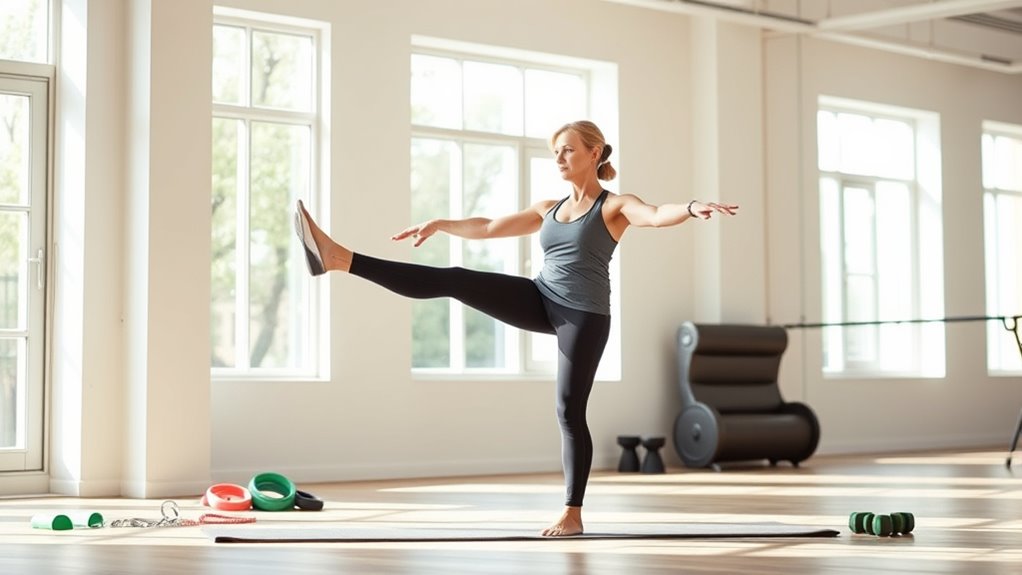
Adding strength training to your routine can boost muscle mass and improve joint stability, helping you stay balanced. Doing exercises like sit-to-stands or heel raises two to three times a week makes a noticeable difference in your strength and mobility. Staying consistent with these workouts is key to maintaining better balance and reducing fall risk. Incorporating consistent exercise routines into your schedule can also enhance your overall stability and prevent falls. Using proper form and gradually increasing resistance can further improve your muscle strength, supporting your balance and reducing injury risk. Incorporating self watering plant pots into your gardening routine can also help maintain consistent moisture levels for healthy plants, similar to how consistent strength training supports your balance.
Strength Training Benefits
Incorporating strength training into your routine offers significant benefits, especially for older adults. It helps build muscle strength and supports joint stability, which are vital for fall prevention. Regular strength exercises, like sit-to-stand and heel raises, target leg muscles and combat age-related muscle loss. Existential themes in physical activity can also motivate consistent engagement in these exercises to improve overall well-being. Engaging in strength training can also help prevent muscle deterioration, which naturally occurs with aging. Building strength is also linked to improved muscle support, reducing the risk of falls and injuries. Strength training can also enhance joint stability, further lowering fall risk. Incorporating exercises that promote muscle regeneration can maximize your progress and benefits. Here are some key benefits:
- Fall risk reduction—strength training can lower your chances of falling by about 30%.
- Balance improvement—strong muscles enhance your stability during daily activities.
- Muscle support—maintaining or increasing muscle mass helps with mobility and independence.
- Enhanced muscle support—strength exercises strengthen leg muscles, aiding in fall prevention.
Adding strength training two to three times weekly boosts muscle support and complements balance exercises for better fall risk reduction.
Consistent Routine Importance
Establishing a consistent routine for strength training is vital for maximizing its benefits and maintaining long-term fall prevention.
By sticking to an exercise schedule, you build muscle strength and stability, which are essential for balance exercises and fall risk reduction.
A consistent routine helps form habits, making fall prevention a seamless part of your health maintenance.
Gradually increasing the duration and intensity of your workouts ensures ongoing progress and adaptation, reducing the risk of injury.
Incorporating strength training into your daily activities enhances overall stability and confidence during movement.
Long-term adherence to a regular exercise schedule not only boosts muscle strength but also sustains the benefits of balance exercises, creating a resilient foundation that supports fall prevention and injury prevention over time.
Regular exercise can also improve glycolic acid benefits, which contribute to healthier skin and overall well-being.
Additionally, maintaining a consistent routine supports exercise adherence, and incorporating diverse training styles like crochet or knitting can provide enjoyable ways to stay active, making it easier to stay committed to your fall prevention efforts.
Furthermore, establishing a proper progression ensures safe and effective improvements in strength and balance over time.
Monitoring Progress and Knowing When to Seek Professional Support
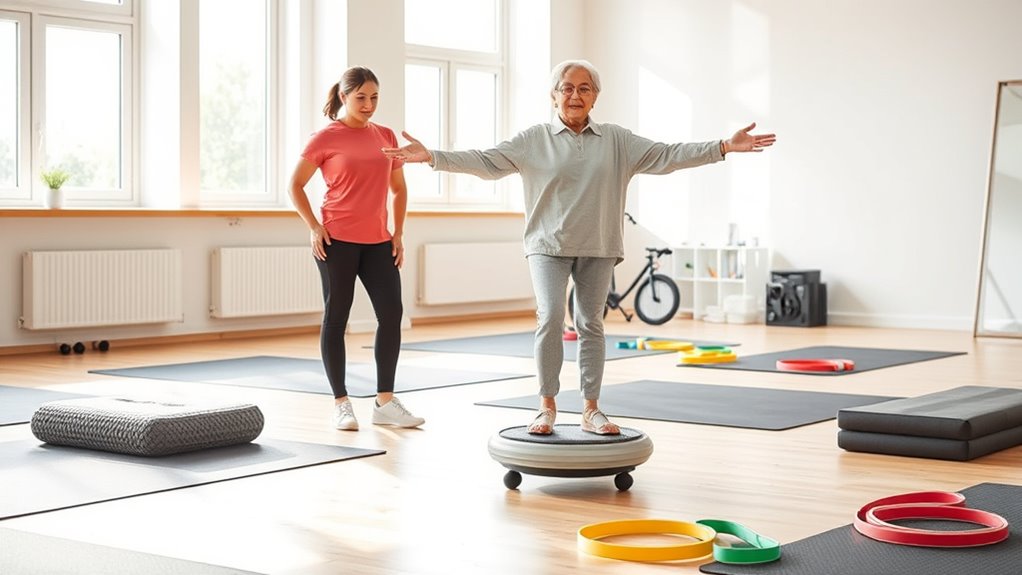
Monitoring your progress is essential to guarantee you’re improving safely and effectively. By tracking your balance performance, you can identify progress markers and decide when to advance your balance exercises. A helpful tip is to incorporate dog names into your routine, such as naming your exercises after your favorite breeds, to keep motivation high. If you notice increased unsteadiness, difficulty holding single-leg stands, or frequent falls, it’s time to seek professional help. Here are some signs to watch for:
- Inability to hold a single-leg stance for 30 seconds
- Walking heel-to-toe without support becomes challenging
- Persistent unsteadiness during exercises
- New symptoms or worsening balance issues
- Changes in balance ability that impact daily activities
A professional assessment, such as a physical therapy evaluation, helps create a personalized exercise routine and address specific deficits. Knowing when to seek guidance ensures fall prevention remains effective and safe.
Frequently Asked Questions
How Can I Improve My Balance to Prevent Falls?
You can improve your balance by practicing simple exercises like standing on one leg or heel-to-toe walking regularly. Incorporate sideways walking, step-ups, or grapevine movements to strengthen muscles and boost coordination.
Use support like a sturdy chair or counter if needed, and aim for 10-15 minutes twice daily. Consistent practice not only enhances stability but also builds confidence, helping you stay safer when walking or standing.
What Are the 5 P’s of Falls Prevention?
Imagine you’re walking and suddenly trip; that’s where the 5 P’s of falls prevention come in.
You focus on Personal factors like health, Posture to keep your balance, Pace to avoid rushing, Pathway to clear obstacles, and Prescription meds to prevent side effects.
What Is the Best Practice for Falls Prevention?
You should focus on a thorough approach to prevent falls. Engage in regular balance and strength exercises tailored to your ability, like sit-to-stand or heel raises, using support tools for safety.
Make home safety modifications and wear proper footwear. Stay active, monitor your progress, and consult healthcare professionals regularly.
This combined effort helps reduce your fall risk and keeps you safer at home and in daily activities.
What Type of Exercise Prevents Falls?
You might be surprised, but the best exercise to prevent falls is one that enhances your stability and strength.
By focusing on balance exercises like standing on one leg or heel-to-toe walks, you actively improve your control.
Strengthening your leg and core muscles through routines like sit-to-stands also helps.
Combining these with proprioception challenges keeps your body agile, making falls less likely and boosting your confidence daily.
Conclusion
By making balance exercises a regular part of your routine, you’ll boost your stability and reduce the risk of falls—almost like turning yourself into an unshakeable fortress! Stay consistent, follow safety tips, and listen to your body. Remember, every small effort adds up to a giant leap in your confidence and independence. Keep moving, stay mindful, and watch your balance become stronger than ever—you’re capable of more than you think!
